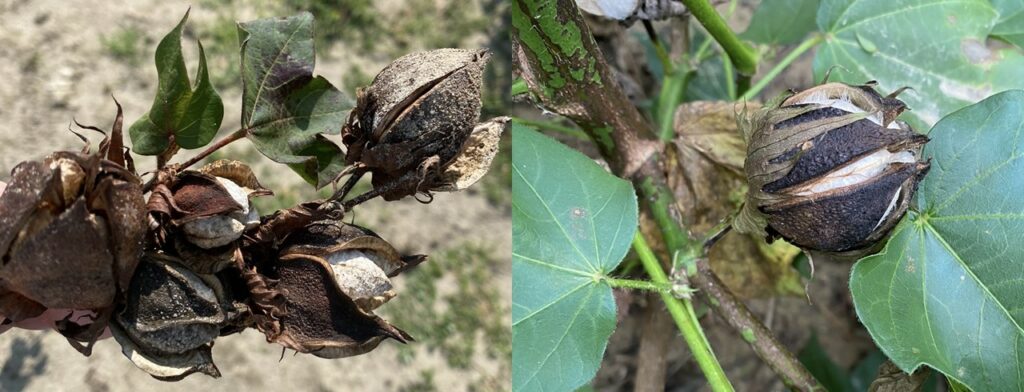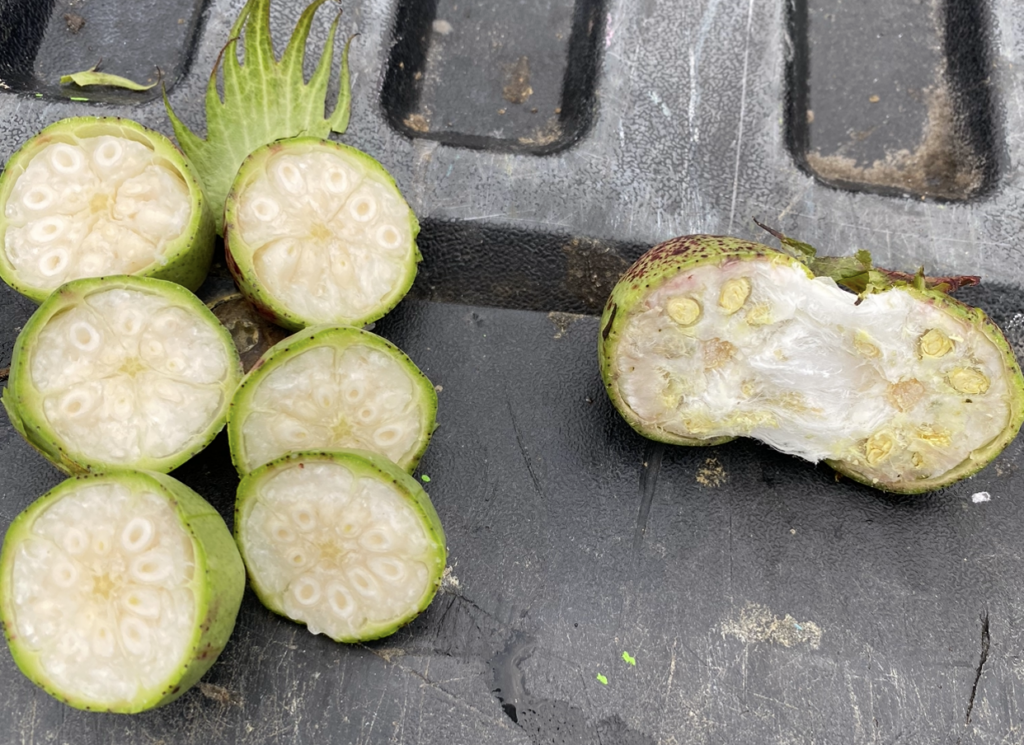Thoughts as We Approach Defoliation and Harvest (Collins & Edmisten)
go.ncsu.edu/readext?1029264
en Español / em Português
El inglés es el idioma de control de esta página. En la medida en que haya algún conflicto entre la traducción al inglés y la traducción, el inglés prevalece.
Al hacer clic en el enlace de traducción se activa un servicio de traducción gratuito para convertir la página al español. Al igual que con cualquier traducción por Internet, la conversión no es sensible al contexto y puede que no traduzca el texto en su significado original. NC State Extension no garantiza la exactitud del texto traducido. Por favor, tenga en cuenta que algunas aplicaciones y/o servicios pueden no funcionar como se espera cuando se traducen.
Português
Inglês é o idioma de controle desta página. Na medida que haja algum conflito entre o texto original em Inglês e a tradução, o Inglês prevalece.
Ao clicar no link de tradução, um serviço gratuito de tradução será ativado para converter a página para o Português. Como em qualquer tradução pela internet, a conversão não é sensivel ao contexto e pode não ocorrer a tradução para o significado orginal. O serviço de Extensão da Carolina do Norte (NC State Extension) não garante a exatidão do texto traduzido. Por favor, observe que algumas funções ou serviços podem não funcionar como esperado após a tradução.
English
English is the controlling language of this page. To the extent there is any conflict between the English text and the translation, English controls.
Clicking on the translation link activates a free translation service to convert the page to Spanish. As with any Internet translation, the conversion is not context-sensitive and may not translate the text to its original meaning. NC State Extension does not guarantee the accuracy of the translated text. Please note that some applications and/or services may not function as expected when translated.
Collapse ▲As we always say, September and October can either preserve our yield potential or chip away at it. This September has certainly been a reminder of that. It comes as no surprise that prolonged wet conditions in many areas of the state have led to some degree of hardlock as illustrated below, however, areas that received intermittent sunshine over the past couple of weeks have faired somewhat better. The current forecast has rains subsiding, and hopefully sunny weather returning, during mid to late next week. Sooner is better than later, but we hope that forecast is accurate.
This September has hedged on the cooler side of normal. As of Labor Day, alot of our crop was 7-10 days ahead of schedule, but now, it is more or less on time. We still have very strong yield potential in places, so we’re still optimistic. It goes without saying that we all need sunshine, and drier warmer conditions to preserve this yeild potential. And we need to avoid any Tropical upsets.
A few thoughts as we approach October……
- Try to target defoliation on days with ample sunshine, followed by another day of sunny weather. It is abundantly clear that defoliating on cloudy days will most likely lead to poor defoliation, requiring a 2nd attempt to completely remove leaves and open bolls. Regardless of the tankmix used, you can expect more complete and overall better defoliation when spraying on a sunny day. Use 20 GPA (no less than 15 GPA) on ground sprayers, and avoid large-droplet tips. A good flatfan or twinfan nozzle, capable of applying the appropriate carrier volume, offers a mixture of fine to course droplets and usually improves coverage
- Avoid defoliating when wet conditions are expected for more than a couple of days. When bolls pop open, the burrs simply need to dry out in order to properly retract and expose seedcotton for harvest. When burrs can not dry out due to wet conditions, they can not retract, therefore resulting in hardlocked bolls as seen below. Thankfully, not many fields have been defoliated yet. Hopefully, sunny weather forecasted for next week will be the trigger for defoliation.

- If you still have closed harvestable bolls, and a Tropical storm is approaching, DON’T DEFOLIATE unless you can reasonably harvest those fields before the storm hits. In most cases, we dont have much certainty of a storm’s likely path that far in advance. The only reasonable case for defoliating before a storm is when nearly all bolls are open, the few remaining closed bolls are very mature, AND you can harvest it before a storm hits. Otherwise, DONT DEFOLIATE. Everyone worries that they’ll get behind if they dont go ahead and defoliate, but staying on time does us no good if our bolls are hardlocked (partially open when a storm hits) or lost due to intense winds and rain (fully open when a storm hits). Remember, closed bolls are protected bolls, and it has been very clear in past years that defoliating in sunnier conditions following a storm preserves a noticeably greater amount of our yield potential.
- DON’T defoliate more than you can effectively harvest 2 weeks later. It does no good in terms of yield or quality to leave cotton fully exposed longer than necessary. Quality of any given boll will be the best that it can be the day that it opens. Beyond that point, quality can remain the same or decline. The more weather it encounters, the more rapidly and severely it will decline. The same applies to yield contribution of any given boll. The more rain or wind that an open boll encounters, the more likely lint will be lost or lose weight.
- Try to get as much done in October as possible. Usually, we dont accumulate many more meaningful heat units beyond mid October in most years, therefore waiting on bolls to mature beyond mid October will be slower and pays less and less. Recent research has illustrated that it may be better to defoliate by mid October, which allows a couple of weeks of some heat units before our average first frost date (late October through early November), which allows our boll openers to work. This research also illustrated that delaying defoliation until just before a frost doesnt allow adequate time for boll openers to perform ideally, therefore the likelihood of opening later set bolls is actually less. On a similar note, once November arrives, drying time of rainfall noticeably increases, our effective harvest hours per day decreases, and lint weight begins to decline after multiple frosts or rains. We can generally achieve alot more by targeting defoliation and harvest in October, within reason, and when given the opportunity.
- With all of that said, defoliate when the crop is ready to be defoliated. We tend to be distracted by peanuts this time of year due to the attention it requires, but with baler pickers, there’s no reason that cotton cant get the attention it is due. Defoliating on time allows us to harvest on time. In some years, it allows for a greater proportion of our crop to be harvested before bad weathe sets in. Slicing upper bolls to determine maturity is the best approach when determining optimal defoliation timing. In the illustration below, the boll on the right is mature enough that it will likely open normally if defoliation is triggered. The seed are well develop and the seed coat is beginning to darken. The boll is also tough to slice and lint is beginning to string out. The bolls on the left need more time….they are not firm to the touch, the seed aren’t well developed and they remain high in moisture. Determining how much more time they need is nearly impossible because it depends on many variables (temperatures, sunshine, etc) but we can expect progress to be slower when temperatures are cooler. Weekly monitoring for maturity is the only way to know how much progress is being made. Once we reach mid October, as mentioned above, we probably need to pull the trigger on defoliation unless noticeably warmer weather is expected beyond that point. Regardless, try to take action well ahead (ideally a couple of weeks ahead) of a frost and use a high rate of ethephon or Finish/Terminate when defoliating.

- The foreseeable forecast (when sunshine is expected to return) has daily highs in the mid 70’s and nighttime lows in the low to mid 50’s. The weatherman loves to change his mind, but that is what we have to go on, for the moment. We can expect some regrowth once this rainy spell subsides, albeit slower growing than normal due to cooler temperatures. With the expected temperatures mentioned above, we will likely need to use a TDZ+diuron product (Ginstar, Adios, CutOut, other generics) to adequately address regrowth versus TDZ alone. TDZ alone will still offer some control, but we can expect it to be slower due to nighttime temperatures, and we will need to use higher rates. Likewise, if some upper bolls are borderline with regard to maturity, we may need to use Finish or Terminate to effectively open them in a timely fashion. Ethephon alone still offers some boll opening activity, but it also will be slower in those cooler temperatures, therefore higher rates will be needed.
- Below are some tankmixtures that are generally very consistent, top-performing mixtures for a broad range of conditions. HOWEVER, they need to be adjusted for temperatures, crop status, and weather yet to come. Call your county agent, consultant, or us, so that we can walk you through the best approach.

Consistent Tankmixtures for Many Environments
Warmer weather:
- Folex 8-12 oz/A
- Ethephon 2 to 2.66 pt/A
- TDZ 3.2 oz/A
- (can use 4 to 8 oz Folex and add PPO if temps are cooler)
- Finish 2 pt/A + Ethephon 11 oz/A (if needed)
- Folex 4 to 6 oz/A
- TDZ 3.2 oz/A
Cooler weather:
- Finish 2 pt/A + Ethephon 11 oz/A (if needed)
- TDZ + diuron 6.4 (most conditions) to 8 oz/A (if cold)
- TDZ + diuron 8 (most conditions) to 10 oz/A (if cold)
- Ethephon 2 to 2.66 pt/A
(no tankmix is bulletproof, there is always risks/rewards associated with any mixture)


